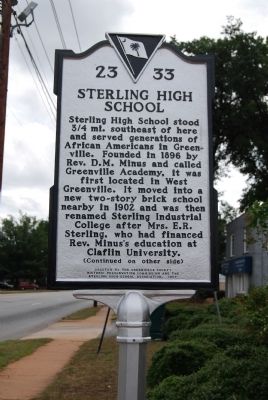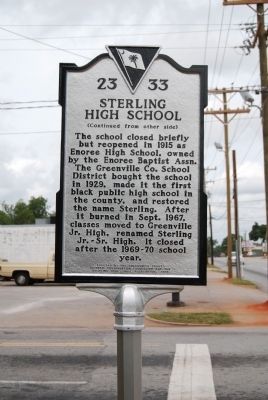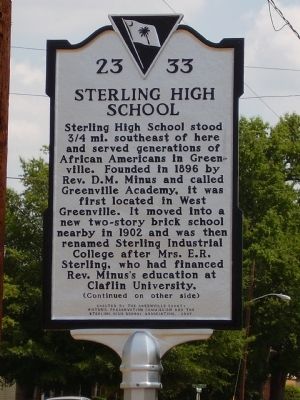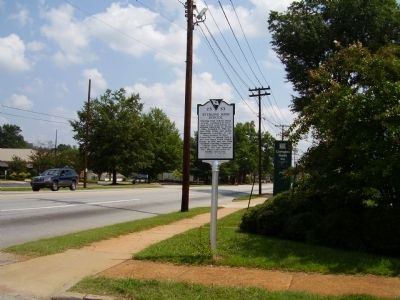Payne-Logan in Greenville in Greenville County, South Carolina — The American South (South Atlantic)
Sterling High School
[Front]:
Sterling High School stood ¾ mi. southeast of here and served generations of African Americans in Greenville. Founded in 1896 by Rev. D.M. Minus and called Greenville Academy, it was first located in west Greenville. It moved into a new two-story brick school nearby in 1902 and was then renamed Sterling Industrial College after Mrs. E.R. Sterling, who had financed Rev. Minus's education at Claflin University.
[Reverse]: The school closed briefly but reopened in 1915 as Enoree High School, owned by the Enoree Baptist Assn. The Greenville Co. School District bought the school in 1929, made it the first black public high school in the county, and restored the name sterling. After it burned in Sept. 1967, classed moved to Greenville Jr. High. It closed after the 1969-70 school year.
Erected 2007 by Greenville County Historical Commission and the Sterling High School Association. (Marker Number 23-33.)
Topics and series. This historical marker is listed in these topic lists: African Americans • Education. In addition, it is included in the Historically Black Colleges and Universities series list. A significant historical month for this entry is September 1967.
Location. 34° 50.589′ N, 82° 24.956′ W. Marker is in Greenville, South Carolina, in Greenville County. It is in Payne-Logan. Marker is at the intersection of Pendleton Street and South Calhoun, on the right when traveling west on Pendleton Street. Touch for map. Marker is in this post office area: Greenville SC 29601, United States of America. Touch for directions.
Other nearby markers. At least 10 other markers are within walking distance of this marker. City Hospital / Greenville General Hospital (approx. 0.2 miles away); a different marker also named Sterling High School (approx. 0.4 miles away); Allen Temple AME Church Bell (approx. 0.4 miles away); Cigar Factory (approx. 0.4 miles away); Greenville High School (approx. half a mile away); Working Benevolent Society Hospital (approx. half a mile away); Trains (approx. half a mile away); Berlin Wall Concrete Pipe (approx. half a mile away); Clay Buchholz (approx. half a mile away); Jim Rice (approx. half a mile away). Touch for a list and map of all markers in Greenville.
Also see . . . Sterling High School. The record of Sterling High School is that of struggle and triumph. It covers a period of nearly seventy-five years. (Submitted on August 29, 2008, by Brian Scott of Anderson, South Carolina.)
Additional commentary.
1. About Sterling High School
The origins of Sterling High School began with the visionary leadership of Reverend Daniel Melton Minus. The primary mission of Minus's move to Greenville in the 1890s was to take over the pastorate of the city's earliest surviving African American church, Silver Hill Methodist Episcopal (soon to be renamed John Wesley Methodist Episcopal). Within a few years, Minus's passion grew to provide local African America children with their first high school. He proceeded to spearhead the organization of an educational committee, finding funding and securing the permits from the state to open the school. His dream became a reality with the opening of the Greenville Academy in 1896 in a humble room at the Silver Hill Church. Enrollment steadily increased and more space was needed to accommodate the growth.
According to Ruth Ann Butler, the school bought the church building and remained in it for several years until trustees decided a new purpose-built structure should be erected. Minus enlisted the financial and organizational help of a number of Greenville's leading Caucasian businessmen, in an unprecedented display of racial unity. The most important contributor was Thomas Parker, who financed the building of the new two-story school in west Greenville on the corner of what would become Jenkins and Maloy Streets. With the move, Greenville Academy was renamed Sterling Industrial College to honor the name of the woman who had financed Reverend Minus's education at Claflin University. Soon new streets and an African American community developed around the school.
The school prospered in its early years under the leadership of Reverend Minus and his successor, Carey Jones. However, the school closed for a short time and was reused as Enoree High School until 1929, when Greenville County bought the building and returned the Sterling name as Sterling High School. The rejuvenated institution went on to produce a the majority of Greenville's future African American leaders.
Joseph Allen Vaughn, Sterling's student body president, became Furman University's first African American undergraduate student admitted when the university desegregated in 1965. He was embraced by the student body and became an officer in the Baptist Student Union, vice-president of the Southern Student Organizing Committee, a sports cheerleader and a volunteer in the Collegiate Educational Service Corps. He also organized and rallied fellow students in civil rights marches in downtown Greenville.
Jesse Jackson attended Sterling and became an honors student as well as the star quarterback for the football team. His talents were good enough to earn him a football scholarship to the University of Illinois in 1959. He went on to get involved as a civil rights activist before going to seminary in Chicago. Just before graduating, he left school to join Reverend Martin Luther King Jr.'s civil rights movement in Alabama. After the death of Dr. King, Jackson led a number of civil and economic rights organizations, including Operation PUSH and the National Rainbow Coalition. Jesse Jackson became the first African American to run for president of the United States in the 1984 race and again in 1988. Jackson continues to be an internationally known civil rights leader.
Other notable graduates of Sterling include Ruth Ann Butler, founder of the Greenville Cultural Exchange Center; Ralph Anderson, South Carolina senator; Lillian Brock Fleming, one of the first female African American Furman graduates and the first African American woman to serve on the Greenville County County; and Xanthene Norris and Lottie Gibson, also both Greenville County Council members.
A significant chapter in Greenville's history closed when Sterling (except the gymnasium) was destroyed by a fire in 1967 and was dissolved three years later when Greenville County schools were integrated. (Source: A Guide to Historic Greenville, South Carolina by John Nolan (2008), pgs. 88-90.)
— Submitted May 24, 2009, by Brian Scott of Anderson, South Carolina.
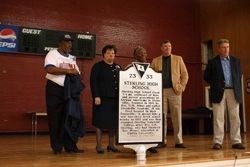
Photographed By Sterling Comminity Center, 2007
5. Unveiling of the Sterling High School Marker
The Sterling community celebrated Martin Luther King Day 2007 with a special program. Members of the Greenville County Historic Preservation Commission officially recognized the Sterling neighborhood as an historic site in Greenville County and local government leaders unveiled the Sterling High School marker.
Credits. This page was last revised on February 16, 2023. It was originally submitted on August 29, 2008, by Brian Scott of Anderson, South Carolina. This page has been viewed 3,203 times since then and 136 times this year. Photos: 1, 2. submitted on August 29, 2008, by Brian Scott of Anderson, South Carolina. 3, 4. submitted on September 1, 2008, by Stanley and Terrie Howard of Greer, South Carolina. 5. submitted on May 24, 2009, by Brian Scott of Anderson, South Carolina. • Christopher Busta-Peck was the editor who published this page.
